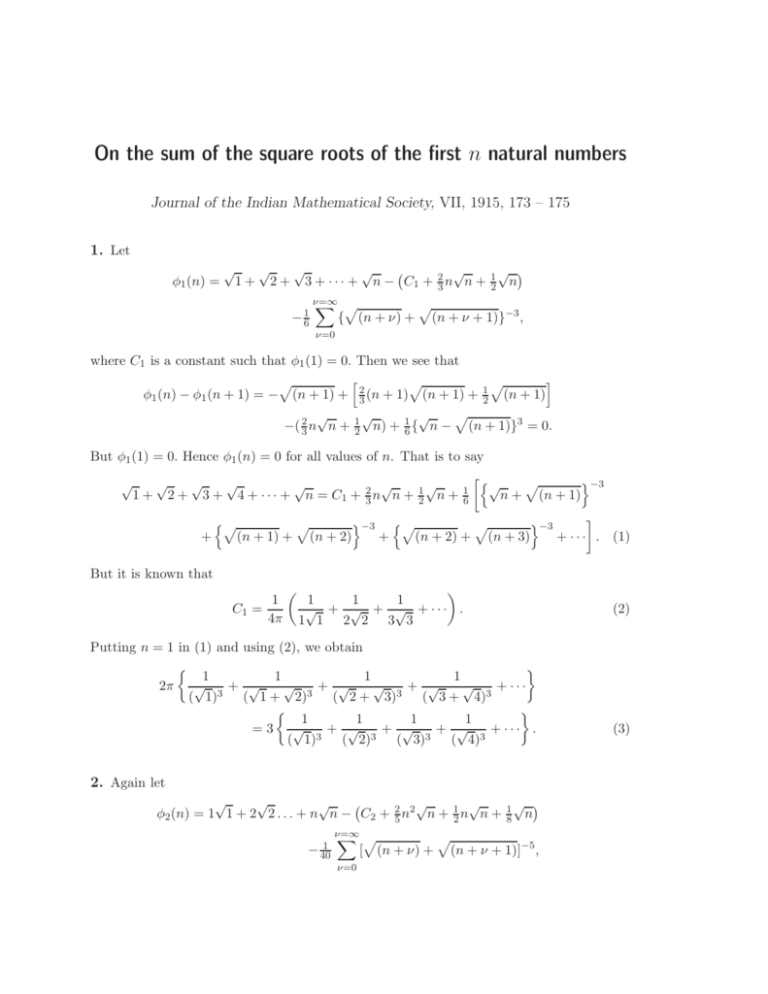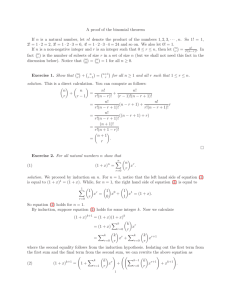On the sum of the square roots of the first n natural numbers
advertisement

On the sum of the square roots of the first n natural numbers
Journal of the Indian Mathematical Society, VII, 1915, 173 – 175
1. Let
φ1 (n) =
√
√
√
√
√ √
1 + 2 + 3 + · · · + n − C1 + 23 n n + 12 n
− 61
ν=∞
X
ν=0
p
p
{ (n + ν) + (n + ν + 1)}−3 ,
where C1 is a constant such that φ1 (1) = 0. Then we see that
h
i
p
p
p
φ1 (n) − φ1 (n + 1) = − (n + 1) + 23 (n + 1) (n + 1) + 12 (n + 1)
p
√
√
√
−( 32 n n + 12 n) + 16 { n − (n + 1)}3 = 0.
But φ1 (1) = 0. Hence φ1 (n) = 0 for all values of n. That is to say
n
o−3
p
√
√
√
√
√
√
√
√
2
1
1
1 + 2 + 3 + 4 + · · · + n = C1 + 3 n n + 2 n + 6
n + (n + 1)
np
o−3 np
o−3
p
p
+
(n + 1) + (n + 2)
(n + 2) + (n + 3)
+
+ · · · . (1)
But it is known that
1
C1 =
4π
1
1
1
√ + √ + √ + ··· .
1 1 2 2 3 3
Putting n = 1 in (1) and using (2), we obtain
1
1
1
1
√
√
√
+ √
+ √
+ √
+ ···
2π √
( 1)3 ( 1 + 2)3 ( 2 + 3)3 ( 3 + 4)3
1
1
1
1
=3 √
+ √
+ √
+ √
+ ··· .
( 1)3 ( 2)3 ( 3)3 ( 4)3
2. Again let
√
√
√
√
√
√ φ2 (n) = 1 1 + 2 2 . . . + n n − C2 + 25 n2 n + 12 n n + 81 n
1
− 40
ν=∞
X
ν=0
p
p
[ (n + ν) + (n + ν + 1)]−5 ,
(2)
(3)
Paper 9
60
where C2 is a constant such that φ2 (1) = 0. Then we have
p
φ2 (n) − φ2 (n + 1) = −(n + 1) (n + 1)
p
p
p
+{ 52 (n + 1)2 (n + 1) + 21 (n + 1) (n + 1) + 81 (n + 1)}
p
√
√
√
√
1
{ n − (n + 1)}5 = 0.
−{ 25 n2 n + 12 n n + 18 n} + 40
But φ2 (1) = 0. Hence φ2 (n) = 0. In other words
√
√
√
√
√
√
√
1 1 + 2 2 + 3 3 + · · · n n = C2 + 52 n2 n + 21 n n + 18 n +
But it is known that
h √
p
{ n + (n + 1)}−5
i
p
p
p
p
+{ (n + 1) + (n + 2)}−5 + { (n + 2) + (n + 3)}−5 + · · · . (4)
3
C2 = −
16π 2
1
40
1
1
1
√ + √ + √ + ··· .
12 1 22 2 32 3
It is easy to see from (4) and (5) that
1
1
1
1
2
√
√
√
√
2π
+ √
+ √
+ √
+ ···
( 1)5 ( 1 + 2)5 ( 2 + 3)5 ( 3 + 4)5
1
1
1
1
= 15 √
+ √
+ √
+ √
+ ··· .
( 1)5 ( 2)5 ( 3)5 ( 4)5
(5)
(6)
3. The corresponding results for higher powers are not so neat as the previous ones. Thus
for example
√
√
√
√
√
5
n)
12 1 + 22 2 + 32 3 + · · · + n2 n = C3 + n( 27 n3 + 12 n2 + 24
p
p
p
√
1
− 96
[{ n + (n + 1)}−3 + { (n + 1) + (n + 2)}−3 + · · ·]
h √
p
p
p
1
+ 224
{ n + (n + 1)}−7 + { (n + 1) + (n + 2)}−7
i
p
p
+{ (n + 2) + (n + 3)}−7 + · · · ;
and so on.
√
√
√
√
7 2
7
13 1 + 23 2 + · · · + n3 n = C4 + n( 92 n4 + 12 n3 + 24
n − 384
)
h √
i
p
p
p
1
{ n + (n + 1)}−5 + { (n + 1) + (n + 2)}−5 + · · ·
− 192
p
p
p
√
1
[{ n + (n + 1)}−9 + { (n + 1) + (n + 2)}−9 + · · ·];
+ 1152
(7)
(8)
On the sum of the square roots of the first n natural numbers
61
The constants C3 , C4 , . . . can be ascertained from the well-known result that the constant
in the approximate summation of the series 1r−1 + 2r−1 + 3r−1 + · · · + nr−1 is
1
1
1
2Γ(r) 1
+ r + r + r + · · · cos 12 πr,
(9)
(2π)r 1r
2
3
4
provided that the real part of r is greater than 1.
4. Similarly we can shew, by induction, that
√
1
1
1
1
1
√ + √ + √ + · · · + √ = C0 + 2 n + √
n
2 n
1
2
3
)
( √
p
p
p
−3
−3 }
{
{
n
+
(n
+
1)}
(n
+
1)
+
(n
+
2)
p
p
+
+ ··· ,
− 12
{n(n + 1)}
{(n + 1)(n + 2)}
The value of C0 can be determined as follows: from (10) we have
p
1
1
1
1
√ + √ + √ + ··· + p
− 2 (2n) → C0 ,
1
2
3
(2n)
as n → ∞. Also
2
1
1
1
1
√ + √ + √ + ··· + p
2
4
6
(2n)
as n → ∞.
Now subtracting (12) from (11) we see that
!
p
√
− 2 (2n) → C0 2,
(10)
(11)
(12)
√
1
1
1
1
1
√ − √ + √ − √ + ··· − p
→ C0 (1 − 2), as n → ∞.
1
2
3
4
(2n)
That is to say
C0 = −(1 +
√
2)
1
1
1
1
√ − √ + √ − √ + ··· .
1
2
3
4
We can also shew, by induction, that
√
√
√
√
√
√
1 + 2 + 3 + · · · + n = C1 + 32 n n + 12 n +
(13)
1
√
24 n
#
" √
p
p
p
{ n + (n + 1)}−5 { (n + 1) + (n + 2)}−5
p
p
+
+ · · · . (14)
{n(n + 1)}
{(n + 1)(n + 2)}
√
√
√
√
The asymptotic expansion of 1 + 2 + 3 + · · · + n for large values of n can be shewn
to be
√
√
1
1
1
1
2
1
−
+
− ··· ,
(15)
C1 + 3 n n + 2 n + √
n 24 1920n2
9216n4
1
− 24
by using the Euler-Maclaurin sum formula.











